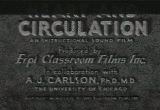Heart and Circulation
Heart and Circulation is a short film from 1937 released on 16mm. It is held in the Prelinger Archives collection.
| Heart and Circulation | |
|---|---|
| Produced by | ERPI Classroom Films, Inc. |
| Animation by | animator |
Production companies | ERPI Classroom Films, Inc. |
| Distributed by | ERPI Classroom Films, Inc. |
Release date | 1937 |
Running time | 10:03 |
| Language | English |
- Thumbnail
More Details
USES ANIMATED DRAWINGS TO SHOW HOW THE HEART & BLOOD VESSELS CIRCULATE BLOOD THROUGHOUT THE BODY. INCLUDES MICROSCOPIC SCENES OF CAPILLARY ACTION & DISCUSSES BLOOD PRESSURE & ITS RELATION TO HEALTH.
Appraisal
Reported excellent for explaining the structure and the action of the heart and circulatory system. Found useful in developing the concept that our organs are interdependent and are affected in their functioning by our daily activities. Found of some use in stimulating an interest in problems related to personal health. Teachers found the film to be complete and well organized and the animated diagrams excellent. The use of the stethoscope to demonstrate the sound of the heart of an old man, a young man, and a baby was particularly effective. When the film is used below the high school level, students should be acquainted with some of the technical terms used by the commentator. In a few instances students objected to the vivisection scenes. Photography and sound are excellent.
Contents
The structure and function of the heart and the circulatory system, presented through animation and natural photography.
A doctor places a stethoscope first on a young man's chest, then on a baby's, and finally on an old man's. (The difference in rate of heartbeat is clearly heard.) In the next scene the slowly beating heart of a dog is exposed. The commentator explains that the heart is a muscular pump. The excised heart of a turtle is shown continuing its muscular action. Animated drawings show the chambers and the valves of the heart as the commentator explains their functioning. The effect of exercise on the rate of the heartbeat is demonstrated by recording a man's heartbeat before and after exercise. When a turtle's heart is irrigated with a warm salt solution, the rate at which it beats increases at once. Adrenalin likewise stimulates heart action. The exposed heart of a dog beats at a slower rate when the vagus nerve is stimulated. The presentation of the circulatory system begins with the function of the arteries. When a dog's artery is cut, blood flows out in spurts. In animated drawings the flow of the blood through the circulatory tract is traced. A microscopic view reveals the slow movement of the blood in the capillaries. A glass tube model is used to demonstrate the reason blood flows more slowly in the capillaries than in the veins. Animated drawings show that blood vessels are able to increase or decrease their caliber by constriction or dilation. As an athlete is shown in action, the commentator explains that the blood vessels in the muscles dilate when the skeletal muscles are active. Dilation and constriction are illustrated by views of a rabbit's ear, the transparency of which makes the blood veins observable. The concluding section of the film deals with various manifestations of blood pressure. A diagram shows that low blood pressure causes the heart to fail to force blood to the head, thus resulting in fainting. The Hales blood pressure apparatus demonstrates that blood pressure is partially dependent upon the rate of ejection of blood from the heart. When the vagus nerve is stimulated, the rate slows down and the pressure falls. Arterial pressure also falls with the loss of blood. As a blood transfusion is made, the commentator says that the transfusion of blood may restore the pressure to its normal level. Arterial constriction and dilation are also shown to affect blood pressure. The automatic adjustment made by the heart and by the capillaries following exercise is demonstrated.
Shot List
stethoscope; doctor; physical examination; actual live human heart beating inside chest; turtle's heart beating outside its body; animation of heart's working and valves; photography of hearts valves; man exercising on gym machinery; turtle heart is experimented on; it's shot with various potions to illustrate various; artery is cut blood spurts; vein is cut; blood flows steadily; animation of exchange of gases and waste products between veins, arteries, heart and lungs; man lifts dumbbells; we see posterior view; photography of blood flow; dog is experimented to cause his blood pressure to change
23:42:39 Doctor listening to man's heart 23:42:44 CU Hand holding stethoscope to baby's chest 23:43:00 Doctor listening to old man's heart 23:43:04 CU Live heart - open chest surgery * 23:43:12 CU Non-human heart held back with tweezers "in situ" 23:43:20 CU Turtle heart beating outside of body 23:45:23 CU Heart valve in action 23:26:25 CU Another animal heart in body 23:46:31 Vivisection - syringe being filled 23:46:51 Another syringe being filled 23:47:23 Arteries (out of body) swollen with blood 23:47:27 CU Scissors cutting artery - blood spurts * 23:48:07 CU Scissors cutting vein - blood runs out 23:48:15 CU Microscopic blood in capillary 23:48:21 CU Microscopic blood in capillary 23:50:30 Surgery on animal 23:51:12 Another surgery shot 23:51:53 Some sort of dissection 23:51:57 Doctor taking woman patient's blood pressure
